Download - The India Economy Review
Download - The India Economy Review
Download - The India Economy Review
Create successful ePaper yourself
Turn your PDF publications into a flip-book with our unique Google optimized e-Paper software.
P LANNING P ARADIGM<br />
played a major role in this recent set of<br />
crises and the resulting recession, remind-<br />
ing us again of the need for light but appropriate<br />
regulation.<br />
So, we are now at a cross-road in terms<br />
of national economic planning. What is<br />
the best mix of reliance on market signals<br />
and government regulation going forward?<br />
While the answers will undoubtedly<br />
change over time and be somewhat<br />
different for each country, and reasonable<br />
people can and will disagree on exact<br />
details, it would be useful to frame the<br />
debate with some general principles. This<br />
brief note is an attempt to provide the essentials<br />
of such a framework.<br />
A few caveats are in order. This paper<br />
is not a comprehensive statement or<br />
analysis of economic development — a<br />
topic still not well-understood. Neither is<br />
this paper intended to be a rigorous<br />
analysis of economic planning. It represents<br />
somewhat of a personal view of<br />
economic planning and it includes somewhat<br />
simplifi ed statements that are nevertheless<br />
directionally correct and appropriate.<br />
It is not a review of the<br />
voluminous economic planning literature<br />
as that has been covered elsewhere (e.g.,<br />
Rostow, 1990).<br />
<strong>The</strong> Environment for<br />
National Economic Planning<br />
Limits of the Corner Solutions: Economic<br />
planning can fail because of many<br />
reasons. First, it may be impossible to<br />
anticipate important trends, infl exion<br />
points, and other changes. Central eco-<br />
24 THE IIPM THINK TANK<br />
nomic planning often places an undue<br />
burden of providing appropriate and<br />
timely information about consumption<br />
patterns to production organizations. As<br />
noted by many conservative economists<br />
like Hayek and von Mises, this is often<br />
impossible and seems to have been a major<br />
reason for the failure of the Soviet<br />
economic system. A second reason for the<br />
failure of central economic planning is<br />
the need to own or control the means of<br />
production to ensure that appropriate<br />
plans are carried out. However, the lack<br />
of private ownership or control makes it<br />
diffi cult to motivate workers to produce<br />
appropriate products effi ciently (e.g., a<br />
collectively owned sick cow may die while a<br />
Markets need reliable public<br />
information; but production of such<br />
information may be too costly<br />
similar privately owned one may survive as<br />
the owner is more likely to take care of the<br />
cow in an all night session if necessary). A<br />
market based economy can overcome<br />
these and other limitations of central<br />
economic planning.<br />
However, market signals are not perfect<br />
either. Markets can be ineffi cient and<br />
subject to bubbles. <strong>The</strong>se imperfections<br />
can result from a number of possible factors.<br />
First, markets need reliable public<br />
information to function; but such information<br />
may be too costly to produce or be<br />
unlikely to be produced by private entities.<br />
Second, market participants may not<br />
behave rationally — numerous behavioral<br />
biases among market participants have<br />
been extensive documented. Third, price<br />
discrepancies in markets need to be arbitraged<br />
away effi ciently but such arbitrage<br />
may be limited not only by information<br />
costs, but also by lack of capital, ability to<br />
assess or take on risks, or limited access<br />
to arbitrage opportunities. Fourth, many<br />
production processes often cannot respond<br />
instantly to new demand and this<br />
necessary delay may induce cyclical variations<br />
and instability in market responses.<br />
Finally, there are many market externalities<br />
that may limit the social value of<br />
market signals (Aggarwal, 2004). Many<br />
economic actions depend on free or underpriced<br />
resources in the “commons”<br />
and many economic actions benefi t a<br />
wider set of agents than the one that bears<br />
the cost of such action. In such cases of<br />
market externalities, market signals based<br />
economic actions are usually ineffi cient<br />
and/or impractical.<br />
Thus, it seems that both the extremes<br />
of central economic planning and complete<br />
reliance on market signals for economic<br />
guidance are imperfect and have<br />
many fl aws and limitations; and neither<br />
extreme is an appropriate approach to<br />
national economic planning. Next we examine<br />
some additional factors that are<br />
useful in thinking about the middle way<br />
of economic planning.<br />
<strong>India</strong>n Environment for Economic<br />
Planning: <strong>The</strong>re are numerous arguments<br />
that have been advanced to support economic<br />
planning. It should be noted that it<br />
is very diffi cult for any government (or<br />
even private) organization to pick industries<br />
and sectors that are winners or even<br />
those that are likely to succeed in the future.<br />
Nevertheless, based on market externalities,<br />
among the arguments put<br />
forward for economic planning in <strong>India</strong><br />
are the following:<br />
First, while <strong>India</strong> in the past was a<br />
wealthy country (even as late as the 18th and early 19th centuries <strong>India</strong> produced ap-





